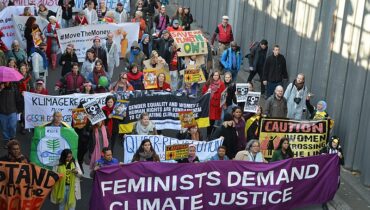Gender’s importance and the vital roles played by women in all facets of development, humanitarian aid, and disaster response are increasingly recognized. But recognition is not implementation. As we see in places like Haiti, Nepal, and even the United States, women are affected differently in disasters—and often suffer the brunt of both immediate effects, and recovery challenges. Women on the ground face challenges such as different nutritional needs, lack of representation, sexual violence, exploitation, and loss of incomes. Many programs and policies now promote mechanisms for reducing these risks and mainstreaming gender-sensitive programming, but most do not include mechanisms to ensure women are incorporated into the highest levels of planning, coordination, and policy development at both a national and international level.
So how can guys help? As a man, I have found that it can be tricky to find my place in supporting gender-inclusiveness, and I doubt I am alone. Some of the struggle comes from not wanting to be seen as patronizing. But I want to help. Recently, I attended an event—From Commitment to Action: Reflections on the 2017 Global Platform for Disaster Risk Reduction organized by the American Red Cross—that prompted me to think in greater detail about how to do that.
I reflected on my desire to help, and not unintentionally hurt, gender inclusivity at the policy and planning level, and arrived at the following question: What exactly is men’s place in improving humanitarian and disaster work by involving more women? While I may not have the ultimate answer, I will try to outline some potential answers in the hope they will prove useful to my colleagues of any gender.
Men “at the table” need to be aware. One event at the Global Platform was initially an all-male panel (or “manel” as one of the other speakers called it). It was only changed at the urging of the IFRC Secretary General, who refused to participate in the event until at least one woman was present on the panel. It took the IFRC Secretary General’s acknowledgement and urging to fix the issue. It could be that none of the other panelists even considered whether both genders were represented. This is something men can do: take a look around. Are there women at the meeting, on the panel, on the team, in the office? If not, why not? It is probably something that should be addressed. There are rarely major efforts to make sure women are involved in high-level planning and coordination processes. For example, OCHA (the UN’s humanitarian coordination body) has many toolkits for gender mainstreaming in its cluster system activities, but none address gender representation at cluster coordination meetings, or mechanisms for elevating gender diversity in international staff. Certainly, not every team may have the capacity for consistent gender diversity. But aiming for it as a best practice should be reasonable for any organization.
Men must facilitate women’s participation—not counter it. One of the event speakers pointed out that there’s a “macho” culture at many meetings and programs, and it can make them more exclusive to women at higher levels of government and organizational planning. What happens when NGO coordination meetings lack gender diversity? When women are excluded from conversations on institutionalizing gender in organizational practices? Or when a team planning a response, even if focused on gender mainstreaming in the field, lacks gender diversity amongst its own leadership? Almost inevitably, when women are excluded—even unintentionally—from these key levels bridging policy and practice, gaps appear. GBV-focused programming in refugee camps becomes focused on reaction, rather than prevention. Gender disaggregated data is not collected. Food aid distribution is overseen only by men. Refugee/IDP camp security is all male. Or any of the dozens of other issues are overlooked. The fact is, including gender diversity in all phases of policy development, planning, response, recovery, and resiliency, is just as vital as taking cultural considerations into account—and often even more feasible. The “macho” culture can be exclusionary, and not just to women. We all need to ensure we are creating an atmosphere in our organizations that fosters contribution, not competition.
Men can use awareness of themselves to help support their female colleagues. We need to be aware of our own biases. We all have them, no matter our gender, no matter how open-minded we are. But when we are aware of what we are thinking, analyzing our assumptions to see if they are reasonable, or unfairly biased, we can ensure that our actions live up to our own ideals.
About the Author
Alex Rohlwing is a graduate research assistant with the Institute, entering his second year in Georgetown’s Conflict Resolution program. Alex has a BA in Cultural Anthropology with a minor in History from the University of Florida. After working in the emergency medical sector as an EMT and Paramedic for several years, Alex turned his attention to disaster and conflict response and recovery. His studies at Georgetown focus on conflicts in emergency and disaster contexts and integrating conflict resilience into disaster recovery.


